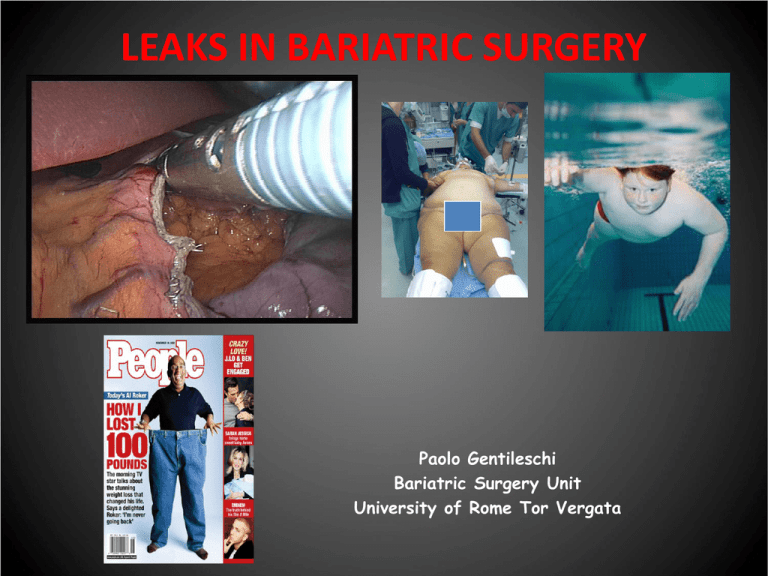
LEAKS IN BARIATRIC SURGERY
Paolo Gentileschi
Bariatric Surgery Unit
University of Rome Tor Vergata
LEAKS IN BARIATRIC SURGERY
+ 142%
LEAKS
Mortalità
< 30 giorni (precoce) : 0,28%
> 30 giorni (tardiva) : 0,35%
Pazienti SuperObesi:
Mortalità Precoce: 1,25%
Mortalità Tardiva: 0,81%
Pazienti con età> 65 anni
Mortalità Precoce: 0,34%
Mortalità Tardiva: 0,0%
Postoperative Adverse Events by Bariatric Procedure in Controlled Trials.
Maggard M A et al. Ann Intern Med 2005;142:547-559
Local and Systemic Factors that negatively influence suture integrity
Local Factors
Systemic Factors
Tissue Hypoperfusion
Malnutrition
Suture Tension
Hypovolemia/Shock
Poor Apposition of Suture Edges
Chemotherapy
Local Infection
Peripheral Vascular Disease
Radiation Injury
Poor Controlled Diabetes
Distal Obstruction
Renal Failure
Glucocorticoids
Sleeve Gastrectomy
Leaks 0-6 %
LEAK RATE BY PROCEDURE
LAGB 0%
LSG 0-7%
LRYGB 0-7%
LBPD 0-6%
RCTs
Int’l Consensus Summits on Sleeve Gastrectomy
Quest.
N. SG
N. SG/surgeon
Sole op.
Leak rate
Bleeding rate
ICSSG-1
Oct
2007
New
York
87
7.500
73.8±133.0
93.8%
2.4±5.3
1.4±2.6
ICSSG-2
Mar
2009
Miami
106
14.476
139.4±214.7
86.3%
2.0±3.3
1.1±1.6
ICSSG-3
Dec
2010
New
York
88
19.605
228.8±275.0
86.4%
1.8±3.8
2.0±5.0
Comparative Use of Different Techniques for
Leaks and Bleeding prevention during
Laparoscopic Sleeve Gastrectomy
M.Anselmino, N. Basso*, P. Gentileschi°, L. Angrisani§,
G. Casella°, D. Benavoli°, S. D’Ugo°, P. Cutolo§,
C. Moretto, R. Bellini, R.D. Berta, S. Franceschi
Bariatric & Metabolic Surgery Unit, Pisa
*VII Dept. of Surgery, Rome La Sapienza
§Dept. Of General Surgery, S. G. Bosco Hospital, Naples
°Bariatric Surgery Unit, Rome Tor Vergata
All cases of primary SG in 4 Italian Bariatric Centers
Center
City
Investigator
A.O.U.P.
Pisa
Anselmino
S. Giovanni Bosco
Naples
Angrisani
Tor Vergata University
Rome
Gentileschi
La Sapienza University
Rome
Basso
1162 Obese Patients
M/F sex ratio
305:857
Age (years)
44,1 (15-72)
BMI
47,0 (27-84)
Gastric Tubule Volume
(ml)
80-110
60 mm firings number
5.8 (5-9)
COMPETITIVE LANDSCAPE
Company
Synovis SI
Covidien
Gore
Baxter
Product Brand Name
Peri-Strips Dry with
Veritas
Duet TRS
SEAMGUARD
Bioabsorbable
FLOSEAL
TISSEEL
Material
Bovine
Pericardium
Synthetic polyester
(Biosyn material)
Glycolide and
Trimethylene
Carbonate
Copolymer
Thrombine
Haemostatic
matrix
+
Fibrin Glue
Host Tissue
Response
Remodels
Reabsorbs
Reabsorbs
-
Tissue thickness
Avg = 0.35 mm
0.20 – 0.60 mm
Avg = 0.07 mm
0.04 – 0.10 mm
0.25 mm
-
Tensile strength
(Peak load)
4.0 kg
TBD
1.2 kg
-
Storage
Controlled room temp
Ambient room temp
Ambient room temp
Preparation
One piece; requires gel
application
Pre-loaded on
stapler loads;
attached with
Biosyn sutures
Two pieces; sleeves
fit on stapler
arms
Reinforcement Type
Total
Type of Reinforcement
N. Pts
No Reinforcement
189
Oversewing
476
Peri-Strip Dry
312
Duet TRS
76
Seamguard Bioabsorbable
63
Floseal+Tisseel
46
1162
Results
Type of
Reinforcement
N.
Pts
Leaks
%
Bleeding
%
No
Reinforcement
189
9
4.76
26
13.7
Oversewing
476
14
2.94
7
1.47
Peri-Strip Dry
312
1
0.32
0
0
Duet TRS
76
6
7.80
1
1.31
Seamguard
Bioabsorbable
63
2
3.17
1
1.58
Floseal+Tisseel
46
1
2.17
0
0
1162
33
2.83
35
3.01
Total
CONCLUSIONS
No evidence at this time for minor incidence of
leaks with either materials or oversewing
- Sufficient evidence of less episodes of bleeding
with reinforcement with either strips
LEAKS
Laparoscopic Sleeve Gastrectomy
Laparoscopic Sleeve Gastrectomy
SERIES (Policlinico Tor Vergata Roma)
March 2013
382 LSG (primary)
6 LEAKS (1.5%)
Laparoscopic Sleeve Gastrectomy
5 healed with :
2 with laparoscopic drainage and TPN
3 with endoscopic clipping and stenting
1 Mortality :
Pulmonary failure and sepsis
IL BY-PASS GASTRICO
Complicanze dopo By Pass gastrico sec.
Roux
Precoci (entro 30 giorni)
Fistola 2-7%
Embolia polmonare 0,2-1%
Infezione ferita 8%
Emorragia 0,8-4,4%
Insufficienza respiratoria 14%
Tardive
Ernia ferita chirurgica 12-15%
Occlusione intestinale 1-3%
Stenosi delle anastomosi 3-7%
Anemia da carenza di Ferro
e/o vitamimina B12 e/o acido
folico 15-33%*
Osteoporosi da carenza di
calcio 8-10% *
Ulcera marginale 1-16%
LEAKS DOPO BY-PASS GASTRICO
Serie (Policlinico Tor Vergata)
Marzo 2013
464 pz
1 leak anastomosi gastro-digiunale (0.2%)
Re-intervento, drenaggio, NPT
1 leak anastomosi entero-entero (0.2%)
Re-intervento, riconfezionamento
STENTING
STENTING
Complicanze Precoci: Leak Anastomotici
La II causa più comune di morte dopo
RYGB
Leak Anastomosi G-J :
Incidenza 2-5%
- LRYGB: 5,2%
- ORYGB:2,6%
Mortalità 1,5%
Tempo medio per la diagnosi: 2 giorni
Leak anastomosi J-J
Mortalità: 40%
Tempo Medio per la diagnosi: 4 giorni
Diagnosi
Leak anastomotici
Segni e/o Sintomi:
Dolori addominale
Tachicardia
Iperpiressia
Aumentati segni di flogosi: VES,
PCR, ProCalcitonina
Leucocitosi Neutrofila
Distress respiratorio
Studio Radiologico:
Rx digerente con Gastrografin
Tc con mdc per os
Leak Anastomotici
Trattamento
Pz Stabile
Pz Instabile
No segni di shock settico,
No segni di ampio Leak
Segni shock Settico
Segni radiologici di ampio Leack
Trattamento Conservativo
Reintervento
Digiuno
NPT
Antibtioticoterapia e.v.
SNG
STENT
Presenza di Raccolta Addominale
Drenaggio percutaneo TC-guidato
Relaparoscopia
Laparotomia
Lavaggio raccolte intraddominali
Posizionamento di Drenaggi Aspirativi
Sutura diretta Leak
Treated 19 patients
with removable covered stents
-acute leaks (n=11)
-chronic fistulas (n=2)
-strictures (n=6)
Leaks were identified endoscopically,
marked radiographically,
and stents deployed under fluoroscopy.
Oral feeding could be started in
79% of the patients after
stenting.
At a follow up of 3.6 months
successful healing was
achieved in :
• 91% of acute leaks
• 100% of gastrocutaneous
fistulas
• 81% of strictures
Mean healing time of 30 days
Treatment of Leaks and Other Bariatric Complications
with Endoluminal Stents
Treatment of acute fistola
Infected fluid collection
Percutaneus or laparoscopic
dranaige
Acute fistola
Applications of stents were
extended to treat esophageal
and gastrointestinal leaks
Healed anastomotic leak after stent
removal
LEAKS
PREVENTION
APPROPRIATE SURGICAL TECHNIQUE
STAPLE LINE REINFORCEMENT (?)
suture
buttress material
sealants
MET BLUE TESTING
NG TUBE (?)
DIAGNOSIS
ENDOSCOPY WITH FLUOROSCOPY
CT SCAN
TREATMENT
CONSERVATIVE
Drainage
TPN
STENTING
Endoscopic clipping or sealants (?)
